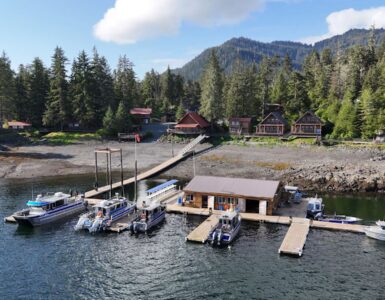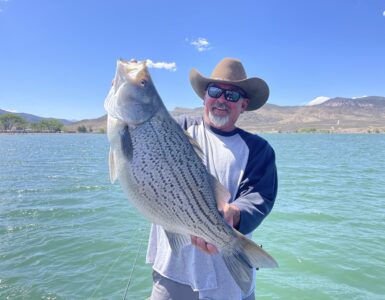(Dale Liechty, DWR Central Reg. Wildlife Biologist) We are heading into a bear den.
Biologists from the Utah Division of Wildlife Resources want to disturb a bears’ slumber by visiting her winter den in hopes of replacing her old radio collar that is running low on batteries with a new one. They are continuing a study that has been going on in Utah for decades.
(Dale Liechty) We are looking at the reproductive over female bears over their lifetime. We want to know when they first will have cubs, how many cubs they have, what sex ratio the cubs are and what the mortality rate is on cubs from one year to the next.
(Dale Liechty) Some of these bears can get themselves into some pretty nasty spots and so you guys are helping us today. Skipping a bunch of miles straight up.
(Ben Tidswell, Chopper 5 Pilot) Anywhere aft of the rear doors is a danger zone. That’s a safe zone, we want to stay in the safe zone.
(Ben Tidswell, Chopper 5 Pilot) Yeah we got asked by DWR to help move some people here from the Spanish Fork airport back up to the top of Hobble Creek. They’ve got a project that they are working on up there, that sounds kind of interesting and you know we are always glad to help out.
(Ben Tidswell) Obviously our aircraft is really set up more of a TV setup more than a utility setup so we’ve got quite a bit of additional weight in there so in order to make sure we are safe and we’ve got good margins of safety we’ll>
(Ben on radio) Spanish fork Five left 270 crossing mid field Eastbound Springville, Hobble creek canyon.
It’s a perfect April day for flying. No wind, crisp air and blue skies. Dale first encountered this bear when she was a cub four years ago. He captured her, put a collar on her and suspects she might have of had her first cub this winter.
The flight wasn’t long, but it was straight up. Chopper Five drops us off at eighty two hundred feet.
(Dale) You know I look down at the bottom of the canyon and I look up here. I would have never had made it. (adam) it’s pretty steep isn’t it. (dale) I would have never made it up here.>
(Dale) She gets into this high country and it’s just really hard to get up here and get in here. (adam) Where do you think she’s at? (dale) I think she’s just right down here.
To get an idea of where collared bears make their dens, biologist, in the winter, fly a fixed winged aircraft with antennas attached to the wings. This however, just gives them a general idea, the rest is done on foot in the spring.
(Dale) So i have her collar frequency entered into here and this is a directional antenna. So where ever you point it, wherever you are getting your strongest beep, is the direction that you head.>
The signal leads us to Day’s Canyon where the East slope is steep and the snow is deep.
(Tom Becker) the meter is pinging out. (adam) so getting close? (tom) pretty close. We are pretty close, just have to be really quiet through here.
(Adam) she’s somewhere close, hopefully she’s doing good and has some cubs. They are pretty confident so lets go find them.
We’ve only been on the trail for about an hour, these guys are good. I think they found it. (tonya) yeah our central region biologists know what they are doing when it comes to knowing our territory. The den we think is right over here. (adam) pretty exciting. Been to a lot of bear dens, never this fast.
welcome back to KSL Outdoors, back here on the top of the mountain. Tonya, show people what you have here. (tonya) I have what is called the Spot Gen III. The unit is made for basically to let someone know you are ok. The check in ok, lets any of our loved ones down at base camp know that we are good. The SOS is the biggest button we don’t ever want to use, but it can be a life saving unit in the unlikely activity that something goes wrong today. We can hit the SOS and it will transmit to a company in Houston and get help to us as soon as possible.>
<(Adam) and what's really cool about this is one of the biologists stayed behind. Tonya was able to link him to our spot, so he is going to be able to track us as we head off the mountain, to make sure we get off ok.
According to the DWR Black Bear Management Plan, biologists make an educated guess on Utah’s bear population based on several factors. They classify bears that have been killed through hunting, removed as nuisance animals and killed by automobiles. Biologists then look at the sex ratio and the age of the animals.
(Covy Jones) so if they start to harvest smaller or younger animals or females. Then we know that our population is down. A lot of our bear management is based on harvest, so it’s retroactive. Bears are doing great, especially in the Central region. We have a lot bear, we are getting bear in areas where we haven’t had bear before so we know they are moving out and the population is doing well.
Everyone had a quick chance to take picture with the cub as biologists finished up with sow.
Then it was back into the den for the baby bear and her mom.
(Dale) this drug that we are using, she won’t remember what we’ve done. We’ll just put her in the den and she’ll just slowly wake up and not know what had happened. (adam) probably best isn’t it. (dale) yeah, yeah.
<(Dale) Probably in a couple of weeks, as big as that cub is she might be coming out of the den.
(Dale) (adam) do you feel that attachment a little bit, just because you work so hard. (dale) yeah we do. We have a lot of study animals and we get attached to them. (adam) well hopefully you see her on some trail cameras this year. (dale) yeah hopefully.
(Covy) now we’ve just got to make it to the truck. (dale) Now the fun begins.>
Time now to take a closer look at the American Black Bear in this weeks edition of our Utah Field Guide brought to you by Community Lending Group.







Add comment